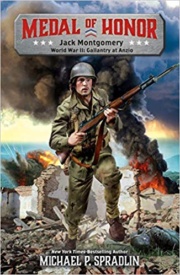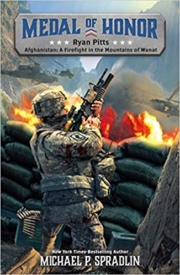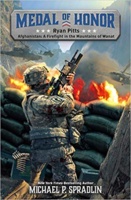Ryan Pitts: Afghanistan: A Firefight in the Mountains of Wanat
Book 2 in the Medal of Honor Series
A book for Older Kids
Staff Sergeant Ryan M. Pitts enlisted in the Army when he was seventeen, and was just twenty-two years old when he fought at the Battle of Wanat in Afghanistan, where his heroic actions earned him the Medal of Honor. On July 13, 2008, Staff Sergeant Pitts was trapped and badly wounded at an elevated outpost, but helped turn back a brutal attack by 200 insurgents and save many of his company in one of the bloodiest battles of the war in Afghanistan.
Read an Excerpt
Enjoy an Excerpt
↓ Jump to Ordering Options
1
Surprise Attack
Wanat village
Nuristan Province, Afghanistan
July 13, 2008, 4:00 a.m.
Well before sunrise, the men of Second Platoon, Chosen Company, were ordered to “stand to.” Dressed in full battle gear and ready to fight, the soldiers took up their positions on the perimeter of Vehicle Patrol Base (VPB) Kahler. The paratroopers in the U.S. Army’s famed 173rd Airborne Brigade had arrived in the village of Wanat, in eastern Afghanistan, on July 8, to secure the area and begin setting up the new outpost.
Chosen Company
As a vehicle patrol base, Kahler was designed to provide a launching pad for patrols in an area that was known to be dangerous. Soldiers in High Mobility Multipurpose Wheeled Vehicles (popularly known as Humvees would provide security and look for signs of insurgents. The army planners hoped that the base would establish a connection with the local population and discourage enemy fighters from traveling through the area.
Upon their arrival, the men of Chosen Company had commenced building up the base defenses. Once they had secured the area with basic obstacles such as concertina wire, sandbags, and antivehicle ditches, army engineers would construct the rest of the installation. To the east of the base on a small, terraced hill, Second Platoon established an observation post called OP Topside to provide clear views of the valley.
If VPB Kahler was a sailing vessel, then OP Topside was the crow’s nest, sitting above the small command post in the center of the base. Topside was protected by sandbags about waist-high—sandbags filled by the soldiers a spadeful at a time in the sweltering heat. Inside Topside were a long-range surveillance system, machine guns, a grenade launcher, ammunition, grenades, and other supplies. The supply of water was limited and was being used carefully.
The observation post butted up against a steep ravine that was overgrown with vegetation. It was a vulnerability, and the platoon had strung coils of concertina wire all along the edge to discourage an attack from that direction. Every night the paratroopers placed antipersonnel mines inside the wire for extra security, recovering them at first light.
As the American soldiers established their base, “it definitely felt like we were being watched,” recalled Sergeant Ryan Pitts. “There were a lot of men sitting along the rock walls outside of the perimeter by the bazaar, or by the hotel; sitting and having tea, just spending a lot of time watching what we were doing.”
Up at OP Topside in the predawn darkness of July 13, Sergeant Ryan Pitts took his position with eight other paratroopers: Sergeant Matthew Gobble and Specialists Jonathan Ayers, Jason Bogar, Chris McKaig, Matthew Phillips, Pruitt Rainey, Tyler Stafford, and Gunnar Zwilling. The platoon leader, Lieutenant Jonathan Brostrom, and the current platoon sergeant, David Dzwik, had given Pitts command of the observation post. Brostrom and Dzwik remained in the command center down the hill at VPB Kahler. If any action was needed, Brostrom would coordinate from there.
It was quiet in the village, but all the soldiers had a sense that something was up. It felt “a little bit odd,” Pitts said later, which was possibly an “indication of what might be coming. Every day leading up to July 13th, at the crack of dawn, people were out there working the fields, and that morning, no one was out there. Often times, in some of the other fights I’ve been in, in Afghanistan, the locals sometimes know that it’s coming, and you can get a sense that something might happen because no one’s around. It’s kind of a ghost town.”
As a forward observer for his platoon, it was Pitts’s job to prepare targets and coordinates for artillery directed at any insurgents in the area. If he or his team spotted an enemy location, he was to report back to the company commander, Captain Matthew Myer, at VPB Kahler. Pitts had set up preplanned targets for mortar and artillery fire, based on his experience in previous fights and where he believed an attack was likely to come from. If required, he could call in mortars, artillery fire, or support from aircraft.
It was not long after taking their positions that soldiers manning the missile truck down at the base spotted potential insurgents moving in the hills to the west in the predawn light. At OP Topside Sergeant Pitts trained the surveillance system on them and started to put together coordinates for mortar fire. Before he could radio the mortar pit, however, a burst of machine gun fire came from the north, at 4:20 a.m.
It was the signal for an attack to begin.
The valley erupted in a hail of bullets and rocket-propelled grenades from all directions. “The whole valley lit up,” Pitts later said.
In the opening salvo, shrapnel from a grenade hit the mortar pit at VPB Kahler, severely injuring Private Sergio S. Abad. The mortarman nonetheless continued to hand rifle ammunition to his sergeant until the order came to evacuate the pit. Only after soldiers pulled Abad to the cover of the command post did they discover his wounds were critical. Abad died in the midst of the battle.
As many as two hundred enemy fighters were attacking. The forty-nine Americans at VPB Kahler were seriously outnumbered.
The Battle of Wanat was underway.
end of excerpt
Ryan Pitts: Afghanistan: A Firefight in the Mountains of Wanat
by Michael P. Spradlin
is available in the following formats:
Digital:
Print:
→ As an Amazon Associate I earn from qualifying purchases. I also may use affiliate links elsewhere in my site.











